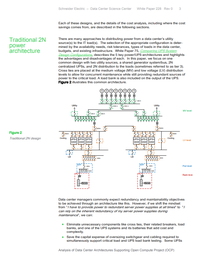The efforts of the Open Compute Project (OCP)1 have opened up an important dialog about the design of data centers. The discussions and detailed specs thus far, have focused primarily on the IT and the rack. In addition, statements about savings have been made without documentation as to how these savings are achieved. This has left some uncertainty as to what the impacts are on the upstream power architecture. We believe that for Open Compute to be widely adopted, we need electrical architectures designed not only with OCP principles in mind, but that also offer a level of redundancy and maintainability that data center operators expect, as well as the flexibility to support both traditional and Open Compute IT equipment.
This paper addresses the following critical questions about the electrical architecture we believe data center managers will want to fully understand before considering an OCP adoption.
- How do OCP rack/server designs affect the upstream electrical infrastructure?
- Can I still achieve 2N redundancy (sometimes referred to as tier 3)?
- How do I support traditional and OCP loads in the same data center?

